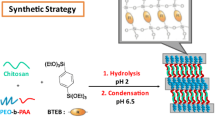Abstract
New organic–inorganic nano-complexes were produced from a micelle of tri-block polymers; poly(styrene)-b-poly(2-vinylpyridine)- b-poly (ethylene oxide) (PS-PVP-PEO) and tungsten compounds such as tungstate (W 2−1 ), undecatungstophospate (PW 7−11 ) and undecatungstosilicate (SiW 8−11 ) in acidic aqueous solutions. The size and morphology of the complexes were characterized by measurements of dynamic light scattering, atomic force microscopy, and scanning electron microscopy. This complex is assembled mainly by the charge interaction between the inorganic polyanions and the positively charged PVP block in the PS-PVP-PEO molecule, which was confirmed by zeta-potential and fluorescence spectroscopic studies. In the absence of the inorganic anions, the zeta-potential of the micelle was +11 mV at pH 3 due to the positive charge of the PVP block. When the inorganic anion was mixed with the PS-PVP-PEO micelle, decrease in the zeta-potential due to charge neutralization occurred with incorporation of inorganic anions into the PS-PVP-PEO micelle. The minimum zeta-potential was 0, −33, and −35 mV for W 2−1 /PS-PVP-PEO, PW 7−11 /PS-PVP-PEO, and SiW 8−11 /PS-PVP-PEO complexes, respectively. Excess negative charge which occurred in the latter two complexes indicates that PS-PVP-PEO molecules bound PW 7−11 and SiW 8−11 by forces other than charge interaction. In addition, the incorporation of an inorganic polyanion into the micelle gave a new morphology to the micelle. In the absence of the polyanion, the PS-PVP-PEO micelles showed an extended conformation due to repulsive forces working among the positively charged PVP blocks. Addition of the polyanion caused the formation of shrunken forms of the micelles, since the charge repulsion was cancelled by the polyanion. This feature may be useful in developing a new type of functioning micelle.






Similar content being viewed by others
Abbreviations
- PW 7−11 :
-
Undecatungstophosphate, (PW11O39)7−
- SiW 8−11 :
-
Undecatungstosilicate, (SiW11O39)8−
- W 2−1 :
-
Tungstate (WO 2−4 )
- POT(s):
-
Polyoxotungstate(s)
- PS-PVP-PEO:
-
Poly(styrene)-b-poly (2-vinylpyridine)-b-poly(ethylene oxide)
- ADN:
-
Apparent degree of neutralization
- DLS:
-
Dynamic light scattering
- AFM:
-
Atomic force microscopy
- SEM:
-
Scanning electron microscopy
- EPM:
-
Electrophoretic mobility
- Py:
-
Pyrene
References
Fischer WR, Schwertmann U (1975) Clays Clay Miner 23:33
Sapiesko RS, Matijevic E (1980) J Colloid Interface Sci 74:405
Cornell RM (1985) Clays Clay Miner 33:219
Tadros ME, Mayes I (1979) J Colloid Interface Sci 72:245
Ishikawa T, Matijevic E (1991) Colloid Polym Sci 269:179
Ishikawa T, Matijevic E (1988) J Colloid Interface Sci 123:122
Kandori K, Horii I, Yasukawa A, Ishikawa T (1995) J Mater Sci 30:2145
Chittofrati A, Matijevic E (1990) Colloids Surf 48:65
Sakai H, Kawahara H, Shimazaki M, Abe M (1998) Langmuir 14:2208
Jana NR, Gearheart L, Murphy CJ (2001) Langmuir 17:6782
Pinna N, Weiss K, Sack-Kongehl H, Vogel W, Urban J, Pileni MP (2001) Langmuir 17:7982
Filankembo A, Andre P, Lisiecki I, Petit C, Gulik-Krzywicki T, Ninham BW, Pileni MP (2000) Colloids Surf A Physicochem Eng Aspects 174:221
Bronstein LM, Sidorov SN, Valetsky PM (1999) Langmuir 15:6256
Förster S, Antonietti M (1998) Adv Mater 10:195
Wegne G, Baum P, Müller M, Norwig J, Landfester K (2001) Macromol Symp 175:349
Cölfen H, Qi L (2001) Chem Eur J 7:106
Cölfen H (2001) Macromol Rapid Commun 22:219
Bronstein LM, Sidorov SN, Gourkova AY, Valetsky PM, Hartmann J, Breulmann M, Cölfen H, M Antonietti (1998) Inorg Chim Acta 280:348
Gohy JF, Willet N, Varshney S, Zhang JX, Jérôme R (2001) Angew Chem Int Ed 40:3214
Lei L, Gohy JF, Willet N, Varshney SK, Zhang JX, Jérôme R (2004) Macromolecules 37:1089
Khanal A, Li Y, Takisawa N, Kawasaki N, Oishi Y, Nakashima K (2004) Langmuir 20:4809
Gohy JF, Willet N, Varshney S, Zhang JX, Jérôme R (2002) e-Polymers No 35
Stepanek M, Humpolickova J, Prochakza K, Hof M, Tuzar Z, Spirkova M, Wolff T (2003) Collect Czech Chem Commun 68:121
Tajima Y (2005) Mini Rev Med Chem 5: in press
Li D, Guo Y, Hu C, Jiang C, Wang E (2004) J Mol Catal A Chem 207:183
Yang Y, Gao Y, Hun C, Wang E (2003) Appl Catal A Gen 252:305
Bragdon JH, Havel RJ (1954) Science 120:113
Tajima Y, Shizuka R, Oshitani S, Amagai H (1990) Thromb Res 57:697
Tajima Y (1997) J Inorg Biochem 68:93
Yamase T, Fukuda N, Tajima Y (1996) Biol Pharm Bull 19:459
Fukuda N, Yamase T, Tajima Y (1999) Biol Pharm Bull 22:463
Tajima Y (2001) Biol Pharm Bull 24:1079
Tajima Y (1999) J Biochem Biophys Methods 38:217
Shaffer CB, Dritchfield FH (1947) Anal Chem 19:32
Harris MJ (ed) (1992) Introduction to biotechnical and applications of poly(ethylene glycol). In: Biotechnical and biomedical applications, chap 1. Plenum, New York, p 4
Kalyanasundaram K, Thomas JK (1977) J Am Chem Soc 99:2039
Dong DC, Winnk MA (1982) Photochem Photobiol 35:17
Wilhelm M, Zhao C-L, Wang Y, Xu R, Winnik MA, Mura J-L, Riess G, Croucher MD (1991) Macromolecules 24:1033
Lakowicz JR (1983) Plenum Press, New York
Author information
Authors and Affiliations
Corresponding author
Rights and permissions
About this article
Cite this article
Khanal, A., Nakashima, K., Kawasaki, N. et al. Fabrication of organic–inorganic nano-complexes using ABC type triblock copolymer and polyoxotungstates. Colloid Polym Sci 283, 1226–1232 (2005). https://doi.org/10.1007/s00396-005-1302-9
Received:
Accepted:
Published:
Issue Date:
DOI: https://doi.org/10.1007/s00396-005-1302-9




